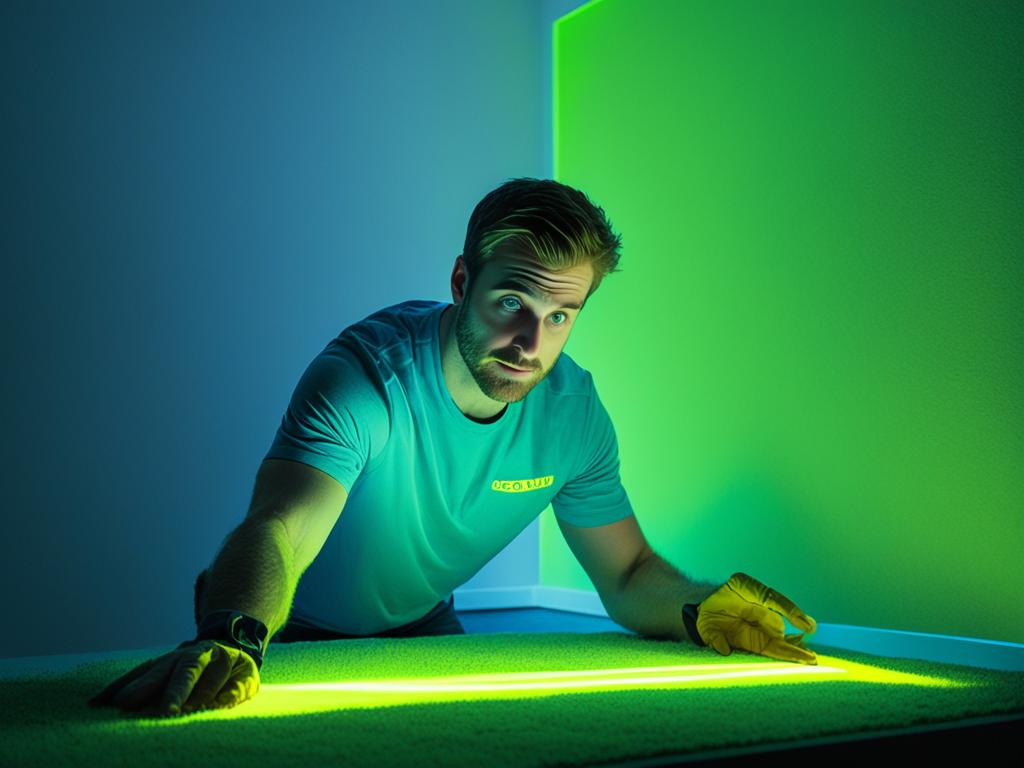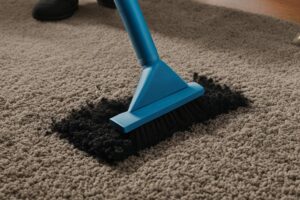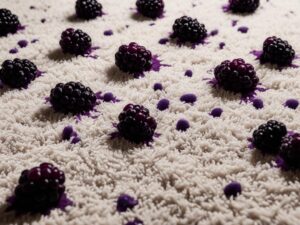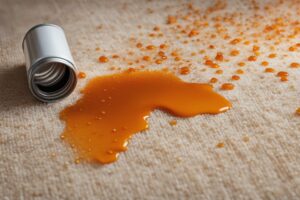Finding urine stains on your carpet can be a frustrating experience, especially if you have pets or young children. While using a blacklight to detect urine stains is a common method, it may not always provide accurate results. There are other methods you can use to identify urine stains and spots in your carpet that can complement the use of a blacklight.
When using a blacklight, it’s important to understand that urine is not the only substance that will fluoresce or glow under its light. Substances such as carpet cleaning products, baby powder, glue, tonic water, and laundry detergents can also produce a glow. Therefore, it’s essential to use other methods in conjunction with a blacklight to get a complete picture of urine in your carpet.
Smelling the affected areas is one way to detect urine in your carpet. Urine has a distinct odor that can be quite strong, especially if it has been sitting for a while. You can also look for physical damage to the carpet fibers, such as discoloration or staining. Urine can cause these changes in the carpet, so they can be a good indication of its presence. Additionally, using a moisture probe or meter can help you determine if urine has penetrated into the carpet backing, padding, or subfloor.
It’s important to note that urine can leave behind crystals and salts even after cleaning. These residues can cause persistent odors, so it’s advisable to consult a professional carpet cleaning technician to assess the level of contamination and provide appropriate treatment.
Key Takeaways:
- Using a blacklight alone may not provide accurate results for detecting urine in carpet.
- Other methods, such as smelling the affected areas and checking for physical damage and staining, can complement the use of a blacklight.
- Using a moisture probe or meter can help determine if urine has penetrated into the carpet.
- Consulting a professional carpet cleaning technician is recommended to assess the level of contamination and provide proper treatment.
- Urine residues can cause persistent odors, so thorough cleaning is essential.
Using a Blacklight to Find Pet Urine
When it comes to detecting pet urine stains in carpets, blacklights are a popular and effective tool. These devices work by illuminating items that fluoresce, including urine, making it easier to identify hidden stains. If you’re wondering how to use a blacklight to detect urine stains, here’s what you need to know:
- Choose a Dark Room: To get accurate results, it’s best to use a blacklight in a dark room. This will enhance the visibility of any fluorescence.
- Hold the Blacklight Correctly: Hold the blacklight about 1-3 inches away from the carpet or surface you want to examine. This distance allows for optimal detection without distorting the fluorescence.
- Look for a Bright Yellow Glow: Urine stains under a blacklight will appear as a bright yellow glow, not bright white as commonly believed. This distinct color indicates the presence of urine.
Using a blacklight to find pet urine stains in carpets has several benefits. It helps you locate hidden stains that may not be visible to the naked eye, allowing for targeted treatment. Once you’ve identified the urine stains, you can use stain and odor removing products specifically designed for pet urine. Enzyme-based cleaners are highly recommended as they effectively neutralize odors and remove stains.
“A blacklight is an invaluable tool for pet owners wanting to detect urine stains in carpets. By following the proper techniques and using the right cleaning products, you can maintain a clean and odor-free environment for your furry friends.”
By utilizing a blacklight and the appropriate cleaning products, you can effectively detect and treat pet urine stains in carpets, ensuring a fresher and cleaner home.
Other Methods to Detect Urine Stains
In addition to using a blacklight, there are other methods to detect urine stains in carpet. By combining these methods with the use of a blacklight, a more comprehensive and accurate assessment of urine stains in carpet can be obtained.
- Smelling the affected areas: Urine has a distinct odor, and a strong smell may indicate urine contamination.
- Looking for physical damage to carpet fibers: Urine can cause degradation and discoloration of carpet fibers.
- Checking for discoloration and staining of fibers: Urine can leave behind visible stains and color changes on carpet fibers.
- Using a moisture probe or meter: Urine can penetrate into the carpet backing, padding, or subfloor, and a moisture probe or meter can detect its presence.
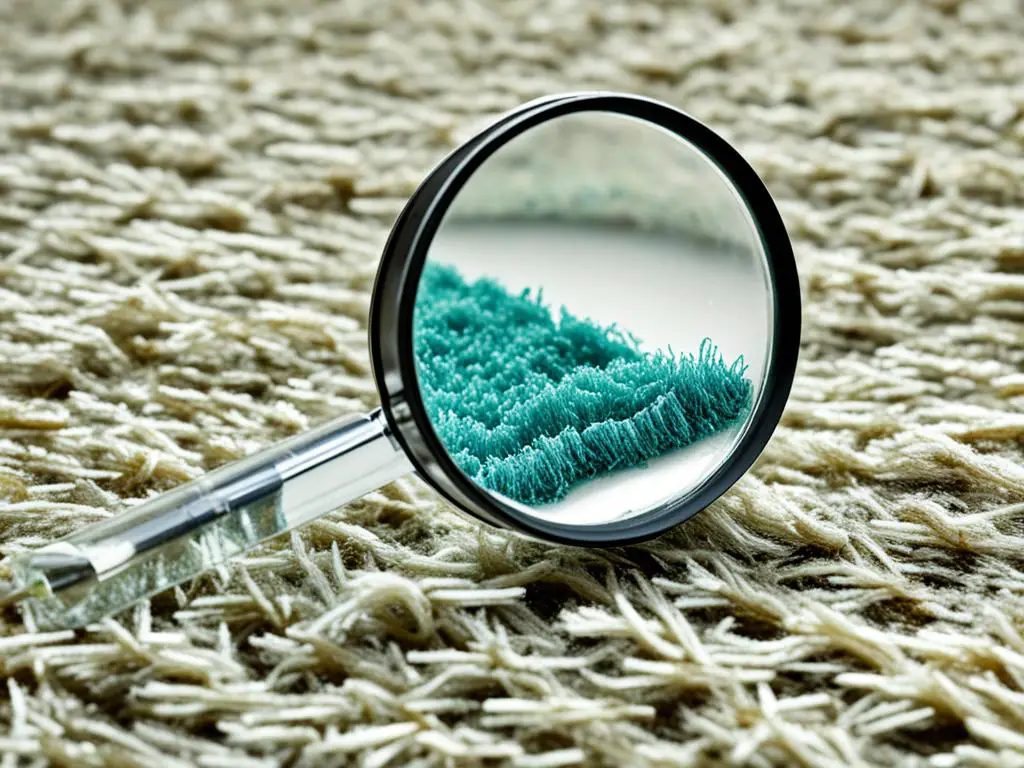
Note: By combining these methods, you can effectively detect urine stains even if they are not visible to the naked eye.
If you suspect urine damage in your carpet, it is important to conduct a thorough examination using these guidelines. The presence of an unpleasant odor, physical damage to the carpet fibers, visible stains, or the use of a moisture probe or meter can confirm the presence of urine stains and contamination.
The Importance of Proper Cleaning
Proper cleaning is crucial when it comes to effectively removing urine stains and odors from carpets. Simple cleaning methods may not be sufficient, as urine salts can linger in the carpet and continue to emit a pungent smell. To ensure thorough cleaning, it is recommended to use enzyme-based cleaners specifically designed for removing urine stains and odors.
Enzyme-based cleaners contain enzymes that break down the components of urine, neutralizing the odor and eliminating the stains. These cleaners are highly effective in removing the urine from the carpet fibers and preventing re-marking by pets.
When using enzyme-based cleaners, it is essential to follow the instructions provided by the manufacturer. Thoroughly saturate the affected area and allow the cleaner to penetrate the carpet fibers and reach the source of the urine. This will ensure complete removal of the odor-causing compounds and stains.
Incomplete cleaning can lead to persistent odor problems as urine salts may remain trapped in the carpet. Pets may detect the residual odor and continue marking the same spot, exacerbating the issue. By properly cleaning and treating urine-contaminated carpets, you can prevent ongoing odor problems and maintain a fresh and clean living environment.
“Proper cleaning is crucial when it comes to effectively removing urine stains and odors from carpets.”
Consulting a professional carpet cleaning technician with experience in urine detection and removal is highly recommended. These professionals have the expertise and specialized equipment to thoroughly clean and treat urine-contaminated carpets, ensuring the best possible results.
Tips for Proper Cleaning:
- Choose an enzyme-based cleaner designed specifically for urine stains and odors.
- Follow the instructions provided by the manufacturer for optimal results.
- Saturate the affected area thoroughly to ensure the cleaner reaches the source of the urine.
- Consider consulting a professional carpet cleaning technician for expert assistance.
By prioritizing proper cleaning techniques and utilizing enzyme-based cleaners, you can effectively eliminate urine stains and odors from your carpet, creating a clean and odor-free environment for you and your pets.
Related images:
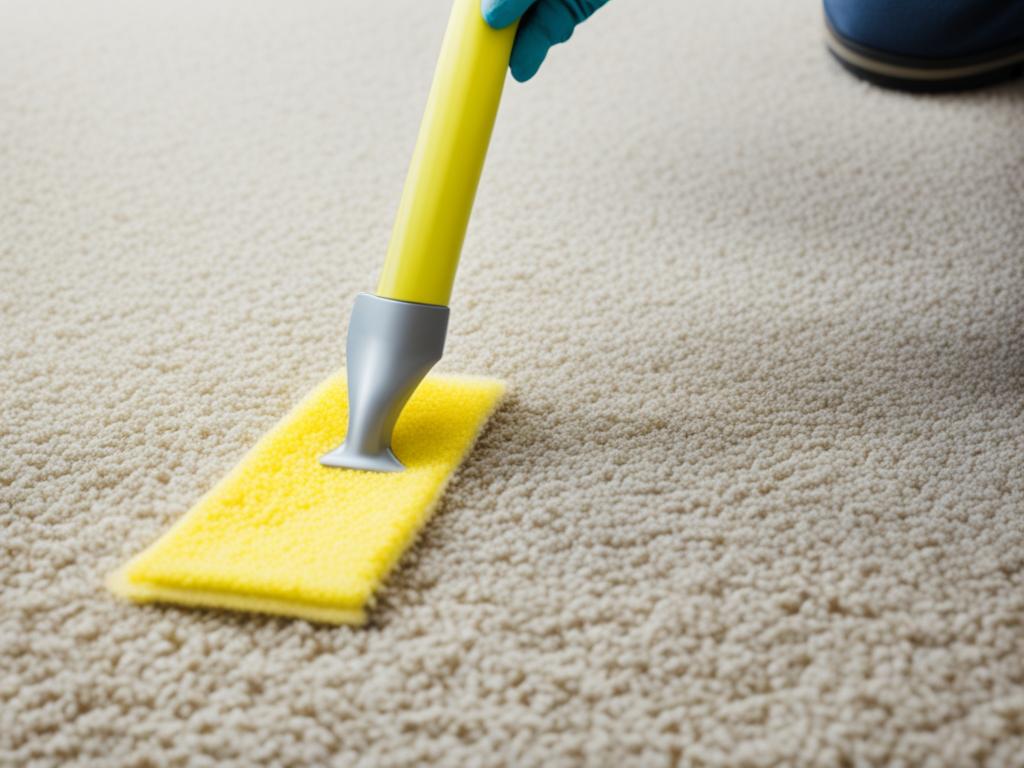
| If Not Properly Cleaned | If Properly Cleaned |
|---|---|
| Persistent urine odor | Odor-free environment |
| Re-marking behavior by pets | Prevention of re-marking |
| Stains and discoloration | Removal of stains |
Common Mistakes and Misconceptions
When it comes to using a blacklight for urine detection in carpets, there are several common mistakes and misconceptions that can lead to inaccurate results. It’s important to be aware of these misconceptions and understand the limitations of blacklight detection.
One common misconception is that urine stains will show up bright white under a blacklight. In reality, urine will appear as a bright yellow glow when illuminated by a blacklight. This misconception can lead to confusion and false interpretations when using a blacklight for urine detection.
Another misconception is that a blacklight is the only tool needed to detect urine stains. While blacklights are a useful tool, they should be used in conjunction with other detection methods for more accurate results. Relying solely on a blacklight can overlook other signs of urine contamination, such as odor, physical damage to carpet fibers, and discoloration of fibers.
Additionally, blacklights can make substances other than urine fluoresce, leading to potential false positives. This can happen with various everyday items such as cleaning products, baby powder, glue, tonic water, and laundry detergents. Therefore, it’s crucial to exercise caution and use multiple detection methods to ensure accurate identification of urine stains.
Limitations of Blacklight Detection
While blacklights can be a helpful tool in identifying urine stains, it’s essential to be aware of their limitations. Blacklight detection has some drawbacks that can affect its reliability:
- Blacklights can make other substances fluoresce, leading to potential false positives.
- Some urine stains may not fluoresce strongly under a blacklight, making them more difficult to detect.
- Blacklights are most effective in a dark room, limiting their usability in well-lit areas.
- Blacklight detection may not be suitable for all types of carpets or surfaces.
To overcome these limitations, it’s important to use a blacklight in combination with other detection methods, such as smelling the affected areas and checking for physical damage and staining of fibers. This will ensure a more comprehensive and accurate assessment of urine stains in carpets.
| Common Mistakes and Misconceptions | Limitations of Blacklight Detection |
|---|---|
| Believing urine stains will show up as bright white under a blacklight. | Blacklights can make substances other than urine fluoresce, leading to potential false positives. |
| Thinking a blacklight is the only tool needed for urine detection. | Some urine stains may not fluoresce strongly under a blacklight. |
| Overlooking other signs of urine contamination. | Blacklights are most effective in a dark room. |
| Blacklight detection may not be suitable for all types of carpets or surfaces. |
By understanding these common mistakes and misconceptions, as well as the limitations of blacklight detection, you can use this tool effectively in combination with other methods to accurately identify and address urine stains in carpets.
Tips for Effective Urine Detection
To effectively detect urine stains in carpet, follow these tips:
-
Use a blacklight in a dark room for better visibility of urine stains.
-
Hold the blacklight 1-3 inches away from the carpet or surface being examined.
-
Look for a bright yellow glow, which indicates the presence of urine.
-
Use other detection methods, such as smelling the affected areas and checking for physical damage and staining of fibers, in conjunction with the blacklight.
-
Exercise caution and be aware of potential false positives caused by substances other than urine fluorescing under the blacklight.
By following these tips and using a combination of detection methods, you can achieve accurate identification of urine stains in carpet.
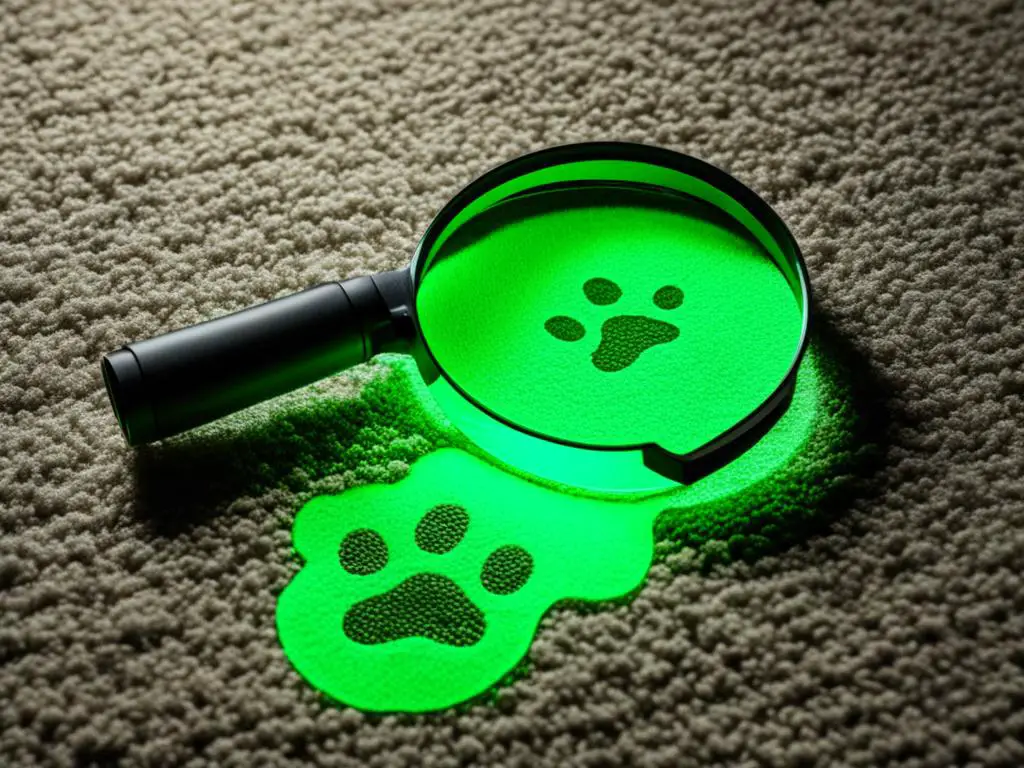
Conclusion
Detecting urine stains in carpet requires a comprehensive approach. While using a blacklight is a popular method, it is important to consider its limitations and potential false positives. By combining a blacklight with other detection methods, such as smelling the affected areas and checking for physical damage and staining of fibers, a more accurate assessment of urine stains can be obtained.
Thorough cleaning is crucial for effectively removing urine stains and odors from carpet. Using enzyme-based cleaners is recommended, as they break down urine components and neutralize the odor. Following the provided instructions and ensuring thorough saturation of the affected area are vital for successful cleaning.
Consulting a professional carpet cleaning technician is highly recommended. They have the expertise to detect and treat urine-contaminated carpets appropriately. By following these guidelines and using effective methods for detecting urine in carpet, you can achieve a fresh and odor-free living space.
